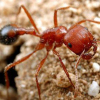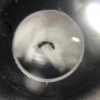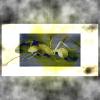- Formiculture.com
- Forums
- Gallery
- Members
- Member Map
- Chat

Where can I buy mites that eat mites on ants
Started By
Broncos
, Nov 13 2019 5:35 PM
16 replies to this topic
#1
 Offline
-
Posted November 13 2019 - 5:35 PM
Offline
-
Posted November 13 2019 - 5:35 PM
I’m seeing some mites on my pogonomyrmex californicus and am not sure if they are parasitic or not but I want to see where I could get mites that eat the mites on ants
Currently Keeping:
Pogonomyrmex Californicus Bicolor & Concolor
Pogonomyrmex Subnitidius
Camponotus Sansabeanus
#2
 Offline
-
Posted November 17 2019 - 10:21 AM
Offline
-
Posted November 17 2019 - 10:21 AM
I’m seeing some mites on my pogonomyrmex californicus and am not sure if they are parasitic or not but I want to see where I could get mites that eat the mites on ants
If they are parasitic, you would see dead ants by now.
"God made..... all the creatures that move along the ground according to their kinds (including ants). And God saw that it was good. Genesis 1:25 NIV version
Keeping:
Formica cf. pallidefulva, cf. incerta, cf. argentea
Formica cf. aserva, cf. subintegra
Myrmica sp.
Lasius neoniger, brevicornis
#3
 Offline
-
Posted November 24 2019 - 1:29 PM
Offline
-
Posted November 24 2019 - 1:29 PM
Half the colony has been wiped outIf they are parasitic, you would see dead ants by now.I’m seeing some mites on my pogonomyrmex californicus and am not sure if they are parasitic or not but I want to see where I could get mites that eat the mites on ants
Sent from my iPhone using Tapatalk
Currently Keeping:
Pogonomyrmex Californicus Bicolor & Concolor
Pogonomyrmex Subnitidius
Camponotus Sansabeanus
#4
 Offline
-
Posted November 24 2019 - 6:04 PM
Offline
-
Posted November 24 2019 - 6:04 PM
I’m not sure about this one, but I think you can search up “predatory mites” on amazon and get those. Not sure if they work though.
Argentine ants are mean.
#5
 Offline
-
Posted November 25 2019 - 6:01 AM
Offline
-
Posted November 25 2019 - 6:01 AM
Ok thanks
Sent from my iPhone using Tapatalk
Sent from my iPhone using Tapatalk
Currently Keeping:
Pogonomyrmex Californicus Bicolor & Concolor
Pogonomyrmex Subnitidius
Camponotus Sansabeanus
#6
 Offline
-
Posted November 25 2019 - 7:27 AM
Offline
-
Posted November 25 2019 - 7:27 AM
No offense man but your colony might be doomed. In the meantime you could try the lemon method, which is putting lemons in the outworld.
My journals:
Polyergus Mexicanus: https://www.formicul...gs/#entry175528
Lasius minutus: https://www.formicul...cs/#entry174811
Lasius latipes: https://www.formicul...gs/#entry206449
General acanthomyops journal: https://www.formicul...yops-with-eggs/
Polyergus Mexicanus: https://www.formicul...gs/#entry175528
Lasius minutus: https://www.formicul...cs/#entry174811
Lasius latipes: https://www.formicul...gs/#entry206449
General acanthomyops journal: https://www.formicul...yops-with-eggs/
#7
 Offline
-
Posted November 25 2019 - 7:39 AM
Offline
-
Posted November 25 2019 - 7:39 AM

This is what I’m seeing
Sent from my iPhone using Tapatalk
Currently Keeping:
Pogonomyrmex Californicus Bicolor & Concolor
Pogonomyrmex Subnitidius
Camponotus Sansabeanus
#8
 Offline
-
Posted November 25 2019 - 4:11 PM
Offline
-
Posted November 25 2019 - 4:11 PM
No offense man but your colony might be doomed. In the meantime you could try the lemon method, which is putting lemons in the outworld.
I agree. From what I've heard about parasitic mites, even if you did order Stratiolaelaps scimitus (I love that one), the colony might be dead by the time they arrived. But you are welcome to try. If you do decide to order, the mites come in large batches (about two thousand each), so be prepared.
Edited by AntsDakota, November 25 2019 - 4:12 PM.
"God made..... all the creatures that move along the ground according to their kinds (including ants). And God saw that it was good. Genesis 1:25 NIV version
Keeping:
Formica cf. pallidefulva, cf. incerta, cf. argentea
Formica cf. aserva, cf. subintegra
Myrmica sp.
Lasius neoniger, brevicornis
#9
 Offline
-
Posted November 25 2019 - 6:43 PM
Offline
-
Posted November 25 2019 - 6:43 PM
Does it look like mites on the ant?I agree. From what I've heard about parasitic mites, even if you did order Stratiolaelaps scimitus (I love that one), the colony might be dead by the time they arrived. But you are welcome to try. If you do decide to order, the mites come in large batches (about two thousand each), so be prepared.No offense man but your colony might be doomed. In the meantime you could try the lemon method, which is putting lemons in the outworld.
Sent from my iPhone using Tapatalk
Currently Keeping:
Pogonomyrmex Californicus Bicolor & Concolor
Pogonomyrmex Subnitidius
Camponotus Sansabeanus
#10
 Offline
-
Posted November 26 2019 - 5:22 AM
Offline
-
Posted November 26 2019 - 5:22 AM
Can't see anything in the picture. You need to get one of those 5 dollar macro lenses from Amazon.
- TennesseeAnts and ANTdrew like this
#11
 Offline
-
Posted November 27 2019 - 10:11 AM
Offline
-
Posted November 27 2019 - 10:11 AM
Does it look like mites on the ant?
I agree. From what I've heard about parasitic mites, even if you did order Stratiolaelaps scimitus (I love that one), the colony might be dead by the time they arrived. But you are welcome to try. If you do decide to order, the mites come in large batches (about two thousand each), so be prepared.No offense man but your colony might be doomed. In the meantime you could try the lemon method, which is putting lemons in the outworld.
Sent from my iPhone using Tapatalk
I thought you said you had seen mites on the ants.....
"God made..... all the creatures that move along the ground according to their kinds (including ants). And God saw that it was good. Genesis 1:25 NIV version
Keeping:
Formica cf. pallidefulva, cf. incerta, cf. argentea
Formica cf. aserva, cf. subintegra
Myrmica sp.
Lasius neoniger, brevicornis
#12
 Offline
-
Posted November 27 2019 - 10:51 AM
Offline
-
Posted November 27 2019 - 10:51 AM
I saw little things on the joints that I didn’t see beforeI thought you said you had seen mites on the ants.....Does it look like mites on the ant?I agree. From what I've heard about parasitic mites, even if you did order Stratiolaelaps scimitus (I love that one), the colony might be dead by the time they arrived. But you are welcome to try. If you do decide to order, the mites come in large batches (about two thousand each), so be prepared.No offense man but your colony might be doomed. In the meantime you could try the lemon method, which is putting lemons in the outworld.
Sent from my iPhone using Tapatalk
Sent from my iPhone using Tapatalk
Currently Keeping:
Pogonomyrmex Californicus Bicolor & Concolor
Pogonomyrmex Subnitidius
Camponotus Sansabeanus
#13
 Offline
-
Posted November 28 2019 - 6:54 PM
Offline
-
Posted November 28 2019 - 6:54 PM
They're probably mites if half the colony is dead.
"God made..... all the creatures that move along the ground according to their kinds (including ants). And God saw that it was good. Genesis 1:25 NIV version
Keeping:
Formica cf. pallidefulva, cf. incerta, cf. argentea
Formica cf. aserva, cf. subintegra
Myrmica sp.
Lasius neoniger, brevicornis
#14
 Offline
-
Posted December 1 2019 - 12:12 AM
Offline
-
Posted December 1 2019 - 12:12 AM
personally i advocate the use of predatory mites as a preventative measure
as people have already said, and from what i have heard, if you have mites your ants could already be doomed
if it was me i would order mites anyway
and if your ants do not survive, cultivate the mites
that way the odds of this happening again are drastically slimmer
i am afraid there is probably not much else you can do
the thing about mites, which i have gathered from my research
is that they come in enormous numbers, get everywhere, and are often there even when you do not see them
this is because they lay eggs everywhere that can lay dormant in almost any condition, and are impossible to get rid of
i have joked about this before to my friends. but the only way you can stop something so unstoppable as that is to fight fire with fire. or, put more humorously, fight mites with more mites.
(lemon therapy is probably worth a shot, though)
Edited by P0rcelain, December 1 2019 - 12:14 AM.
#15
 Offline
-
Posted December 3 2019 - 4:30 PM
Offline
-
Posted December 3 2019 - 4:30 PM
I believe the mites you are looking for (made famous by AntsCanada) are hypoapsis miles, now named Stratiolaelaps scimitus. If you search online some places offer them. I would’ve bought some but apparently they will eat bee larvae so I’m a little concerned they might eat ant brood.
Formiculture Journals::
Veromessor pergandei, andrei; Novomessor cockerelli
Camponotus fragilis; also separate journal: Camponotus sansabeanus (inactive), vicinus, laevigatus/quercicola
Liometopum occidentale; Prenolepis imparis; Myrmecocystus mexicanus (inactive)
Pogonomyrmex subnitidus and californicus (inactive)
Tetramorium sp.
Termites: Zootermopsis angusticollis
Isopods: A. gestroi, granulatum, kluugi, maculatum, vulgare; C. murina; P. hoffmannseggi, P. haasi, P. ornatus; V. parvus
Spoods: Phidippus sp.
#16
 Offline
-
Posted December 3 2019 - 6:43 PM
Offline
-
Posted December 3 2019 - 6:43 PM
personally i advocate the use of predatory mites as a preventative measure
as people have already said, and from what i have heard, if you have mites your ants could already be doomed
if it was me i would order mites anyway
and if your ants do not survive, cultivate the mites
that way the odds of this happening again are drastically slimmer
i am afraid there is probably not much else you can do
the thing about mites, which i have gathered from my research
is that they come in enormous numbers, get everywhere, and are often there even when you do not see them
this is because they lay eggs everywhere that can lay dormant in almost any condition, and are impossible to get rid of
i have joked about this before to my friends. but the only way you can stop something so unstoppable as that is to fight fire with fire. or, put more humorously, fight mites with more mites.
(lemon therapy is probably worth a shot, though)
How do you recommend cultivating mites? I have tons of springtails so I could imagine making a container of springtails and just adding stratiolaelaps to it?
Formiculture Journals::
Veromessor pergandei, andrei; Novomessor cockerelli
Camponotus fragilis; also separate journal: Camponotus sansabeanus (inactive), vicinus, laevigatus/quercicola
Liometopum occidentale; Prenolepis imparis; Myrmecocystus mexicanus (inactive)
Pogonomyrmex subnitidus and californicus (inactive)
Tetramorium sp.
Termites: Zootermopsis angusticollis
Isopods: A. gestroi, granulatum, kluugi, maculatum, vulgare; C. murina; P. hoffmannseggi, P. haasi, P. ornatus; V. parvus
Spoods: Phidippus sp.
#17
 Offline
-
Posted December 10 2019 - 2:17 PM
Offline
-
Posted December 10 2019 - 2:17 PM
from my research, same way you would cultivate other small, earth dwelling insects. but you would want to ask someone who has actually done it.
1 user(s) are reading this topic
0 members, 1 guests, 0 anonymous users




















